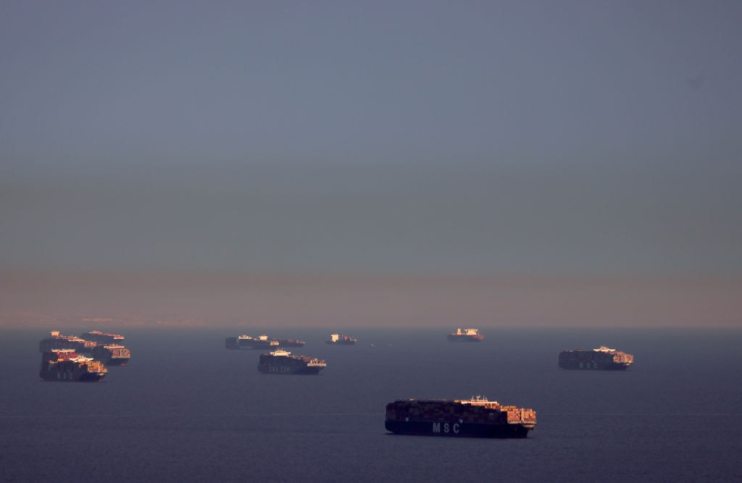Long read: Untangling the shipping crisis will take more than a favourable wind

IT IS EASY to forget how lucky we are in the UK. A rapid vaccine rollout has almost entirely banished the spectre of Covid-19 from the country’s economy. But, there are signs the pandemic is still stopping the world from getting back to normal – none more so than in the global shipping industry.
Covid-19 continues to be a drag on productivity at ports across the world.
Ongoing Covid-19 restrictions have disrupted port staffs’ work flows at the globe’s major shipping hubs, particularly in Asia, meaning they are struggling to process the same volume of orders.
This has contributed to a backlog of crates and lengthened delivery times at ports in the UK, US, Europe and, most notably, in Asia, the world’s trading linchpin.
Delays for containers moving between the Chinese port of Shanghai and the Netherlands’ Rotterdam port widened from 1.88 days to 15.19 days over the last year, according to tracker firm project44.
Just last weekend, 87 cargo ships were waiting to get into a Los Angeles port. Backlogs have become so bad that US President Joe Biden launched a “90-day” sprint to try and ease the pressure.
China’s adoption of a zero tolerance Covid-19 policy has led to ports that record just a handful of cases shutting immediately. Given the country is one of the world’s main shipping arteries, this policy has hampered the efficiency of the world’s logistics system, which has reduced the supply of cargo ships that are ready and able to move goods around the world.
As a result, firms are competing to secure limited spots, which is putting upward pressure on freight prices.
According to the Freightos Baltic Index, shipping costs are over four times higher than they were a year ago.
The monthly average market price for China-EU routes for a 40-foot container increased from $1,650 to $12,977.
“Covid-19 has caused major supply chain issues and we have seen a shortage of containers around the world, driving up the prices of moving goods,” the UK Chamber of Shipping said.
WORKER SHORTAGES BITE
Shortages of workers plaguing economies across the world are snaring firms’ operations – including shipping businesses.
Restricted labour supply is impacting shipping flows in two ways. Firstly, at the ports themselves there are fewer workers to process deliveries and oversee mooring.
Specifically in the UK, a lack of lorry drivers, exacerbated by Brexit, has caused crates to swell at one of the country’s main ports in Felixstowe. HGV drivers are a crucial cog in the shipping wheel as they take cargo away for delivery, which frees up space at ports for the next wave of shipments.
An absence of workers to run down crate volumes at Felixstowe was one of the main reasons that resulted in Maersk steering away from the port, threatening retailers’ supplies over the Christmas period in the process.
Data released by the Office for National Statistics yesterday shows exports of UK goods to both EU and non-EU countries shrank over the last month.
The ONS pegged this on “staff shortages across a number of industries because of self-isolation and a significant shortage of HGV drivers.”
The US is also suffering from an acute shortage of seafarers and lorry drivers.

EVERYBODY STILL WANTS GOODS
Capacity pressures have been intensified by changes in consumption patterns generated by Covid-19 catching shipping firms off guard.
Amid the enforced shutdown of most of the world’s services industry, consumers rapidly switched to substitute products. In the UK, this mainly involved DIY home improvement products, electronics and the lockdown essential – loungewear.
Preferences differed by country, but consumption had one key thing in common: demand for goods rose sharply.
This is fine amid depressed economic activity. However, once the pandemic eased, friction emerged.
Shipping firms are now processing elevated orders for consumer-goods and intermediate goods used by construction and manufacturing firms.
“The sharp contraction in demand in 2020 led many businesses to slash orders of intermediate inputs.
“As the recovery picked up steam in 2021, some producers found themselves flatfooted and unable to ramp up sufficient supply again quickly,” the International Monetary Fund said this week.
The distribution of spending between goods and services has yet to fully equalise, meaning higher than average demand is rubbing up against lower than needed supply, putting upward pressure on shipping prices.
Josh Brazil, vice president, at project44, said: “There’s no quick fix here. Unless demand drops significantly after the holiday rush, this could be a multi-year problem.”
Read more: Editorial: If tax cuts worked in a crisis, why not after it, too?